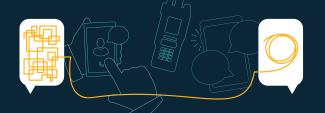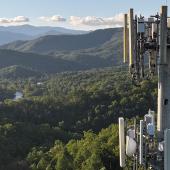Over the last decade, the role of today’s fire and rescue service has grown exponentially to meet the changing demands of an increasingly complex society. More than ever, firefighters are called upon to respond to a growing number of natural disasters, biological dangers, terrorist threats and man-made incidents that far exceed traditional fire service duties.
With FirstNet available nationwide, the network is designed to keep pace with the mounting strain placed on the fire service. FirstNet is the only Nationwide Public Safety Broadband Network (NPSBN) specifically designed to operate at a much higher level than a commercial network. Our public safety design from the ground up offers true priority and preemption.
For our nation’s firefighters, FirstNet offers one communication platform to deliver distinct benefits that protect our frontline responders from harm by enhancing coverage and capacity during times of need, expanding situational awareness and interoperability, and harnessing broadband to support the latest technologies.
Here are four examples of how FirstNet services and features are being used by fire personnel to save lives, protect communities and infrastructure nationwide.
Expanded network capacity and coverage during Oregon’s wildland fires
When wildfires roar through remote or rural lands, the need for reliable coverage and capacity for first responders is more crucial than ever. During the raging Miles Fire near Prospect, OR, FirstNet played a pivotal role maintaining emergency communication for the Tualatin Valley Fire and Rescue Department. FirstNet deployed a Satellite Cell on Light Truck (SatCOLT) to bolster communication for the nearly 2,000 first responders that were called in from neighboring jurisdictions to help contain this major fire. When the fires forced the community to evacuate their homes, the SatCOLT extended the coverage area and capacity for first responders to coordinate their response and recovery efforts.
“Before FirstNet deployed the SatCOLT to our base camp, our first responders couldn’t send a text message, let alone speak on the phone to their families,” said Tualatin Valley (OR) Fire & Rescue Fire Chief Mike Duyck. “As it stands today, we might have weather challenges, but the coverage FirstNet is providing is meeting our needs, giving us better situational awareness, and bringing comfort to our responders during a time of stress and anxiety.”
FirstNet’s deployable assets, like drones, blimps, and SatCOLTs provide the fire service with a highly reliable connection and additional capacity during natural disasters or large events when additional coverage is needed. The deployable connection makes it possible for firefighters to stay connected to their incident command structure, their fellow firefighters and to receive critical data such as changing weather patterns, shifting fire lines or divisional maps with live resource locations in real-time to save lives.
Enhanced interoperability and situational awareness for firefighters in Missouri
As technology continues to evolve, public safety agencies nationwide have access to an unprecedented amount of information. FirstNet runs over public safety’s dedicated spectrum, Band 14 - which gives the network the robust capabilities to easily collect, analyze and turn this data into actionable, life-saving information. In turn, first responders can access and share real-time data to make decisions quicker and increase the situational awareness surrounding large events or emergencies.
When planning began for the annual Lake of the Ozarks Race in Missouri, the Lake Ozark Fire Protection District and Osage Beach Fire Protection District arranged for FirstNet to support interoperable communication for a wide range of state and local public safety agencies that required uninterrupted real-time communications. On race day, FirstNet deployed a SatCOLT to enhance situational awareness as the day’s events unfolded. To ensure efficient and effective communication between land and water patrol agencies, the FirstNet team set up fire services, law enforcement and EMS pre-programmed talk groups with FirstNet’s Enhanced Push-to-Talk (EPTT) capabilities. Agencies also used public safety specific location tracking solutions to access GPS services to keep track of the activities along the four-mile race course.
“The event went very well and the communication with the EPTT and to have the deployable on site made our communications between command and patrol boat work flawlessly,” said Matthew Birdsley, Assistant Fire Chief, Lake Ozark Fire Protection District.
FirstNet serves firefighters in Florida in every day operations and every emergency
For the Miami-Dade Fire & Rescue Department (MDFR) in Florida, FirstNet serves as one communication solution for firefighters in every day operations, emergency response and during large events. Serving as the connection for mobile data computer terminals in the fire apparatus, FirstNet makes it possible for firefighters to use computer aided dispatch and tablets to connect to emergency medical services patient care reports when responding to a health crisis. For disaster response, the MDFR urban search and rescue team, Florida Task Force 1, has requested FirstNet network deployable assets to extend coverage and capacity when responding to extreme weather events.
And during Super Bowl LIV, the MDFR relied on FirstNet for push-to-talk capabilities allowing responders to expand their operational footprint using both traditional land mobile radio communications (LMR) and LTE communications throughout the entire event. With the recent launch of the FirstNet Push-to-Talk (FirstNet PTT) solution, first responders have access to the first-ever nationwide mission-critical standards-based push-to-talk solution.
We had the chance to chat with MDFR’s Chief Greg Rubin weeks before the big event. “We’re looking forward to testing the technology of FirstNet and its dedicated resources for first responders,” explains Chief Rubin. “At the Super Bowl, we plan to deploy a MCPTT-type of capability – our first responders will have both traditional LMR and LTE voice services, so we can have a backup and a primary for non-critical services and logistics support.”
FirstNet supports predictive technologies to protect the health and wellbeing of firefighters and the communities they serve
While FirstNet’s primary mission is to advance first responder communication in day-to-day and emergency operations, the network’s robust platform also has the ability to support technological solutions that compile and share vast amounts of “on the scene data” to detect health risks that often go unnoticed or untreated. With FirstNet, it is possible to keep both the community and first responders safer and more secure from unnecessary and avoidable hazards by harnessing real-time data sharing from “smart” technologies, such as: augmented reality equipment, location based service tools and Geographic Information System (GIS) mapping capabilities, sensors to monitor heat, heart rate or air consumption and the list goes on.
Last winter, Newport County, RI experienced low gas pressures that left more than 7,100 residents without heat in single-digit temperatures. Using FirstNet-supported technology and applications, the Newport Fire Department and the Rhode Island Emergency Management Agency (RIEMA) used FirstNet-ready phones and Wi-Fi hotspots to organize wellness checks and prioritized restoration of critical infrastructure for residents impacted by the outage. By collecting and sharing information about potential gas exposure in the community, the Newport Fire Department and their public safety partners uplifted the information to the cloud where it was easily assessable to emergency response personnel from the state emergency operations center.
During the wellness checks, an elderly resident reported smelling gas to the first responders going door-to-door. Firefighters notified the dispatch center in real time and were able to rapidly evacuate the woman and secure the open gas valve.
These are just a few examples of how FirstNet can benefit our firefighters on the frontline. Explore our website for more information on the FirstNet Authority, our Roadmap and how FirstNet is helping transform communications for fire services. Contact your local FirstNet Authority Public Safety Advisor and sign up for our Fire Services quarterly newsletter. For more information on FirstNet products and services, visit FirstNet.com.




















